 |
 |
Billionaire Beats Gold Medalist at HeinekenMarch 8 - St. Martin 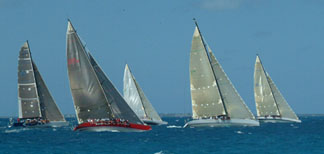 In order: Morning Glory, Pyewacket, Equation, the R/P 78 Titan, and the Volvo 60 Venom The big story at the just-concluded Heineken Regatta in St. Martin, indeed, the big story in the world of yacht racing, was the debut of the two MaxZ86s, Roy Disney's Pyewacket and Hasso Plattner's Morning Glory. These boats did not fail to impress - even those who were initially skeptical.  Pyewacket at the leeward mark Dee Smith of Novato, the project manager and tactician on Morning Glory, and Stan Honey, the Peninsula-based navigator on Pyewacket, struggled to come up with superlatives for the boats. Both reported they are much better at beating, reaching, and running than similar boats without the canting keels and forward canard rudders. The one fly in the ointment is that canting the keels requires use of the engine. In fact, every time the keel is moved - which is virtually all the time - the engine revs up. It's quite noisy. Nonetheless, these boats showed stunning speeds and pointing ability. "It's made yacht racing exciting for me again," said Smith, who has been doing it all for close to 30 years. 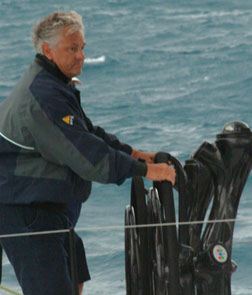 Hasso Plattner, a lifelong sailor, including aboard dinghies, at the helm of Morning Glory Morning Glory
took top honors, with Roger Sturgeon's San Francisco-based TransPac
52 Rosebud, a winner at the Big Boat Series and Key West,
second. Pyewacket was third. With owner Plattner, founder
of SAP software, driving Morning Glory and besting Robbie
Haines, Olympic medalist and helmsman, some people came up with
the line 'billionaire beats gold medalist'. But Plattner, a long
time competitive sailor, is no slouch at sailing. Further, Smith
was quick 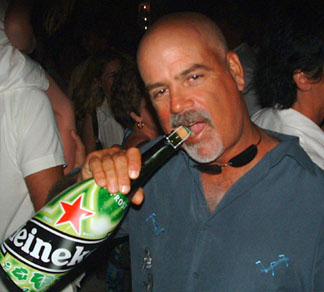 Dee Smith, project manager and tactician for the victorious Morning Glory, hams it up to please the photographers. In the wild world of billionaires, we were
told that Plattner had flown off the island before some of the
other boats in the class had crossed the finish line. If that's Conditions at the Heineken were challenging
for the 250+ boats. In all of the four races there were periods
when the wind was in excess of 30 knots, and it was rarely below
20. In the Anguilla Channel, the waves were big, steep, and close
together. The conditions were hardest on the multihull classes,
where three of the 19 entries dropped their rigs, and there was
considerable other damage. But 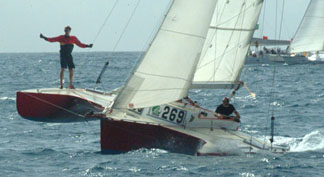 Some of the 'biggest bang for the buck sailing' was enjoyed by owners and crews of '70s vintage trimarans such as Tryst. They were wet and wild.  The little tri Charis was another big bang for the buck boat, hitting in excess of 20 knots here. 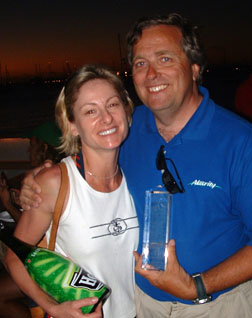 At least five masts came down, including that of the lovely 70-ft Hoek designed Kim. Three of the multihulls lost their rigs. The most spectacular dismasting happened on the first leg of the first race, when Rex and Celeste Conn's 50-ft extreme tri dropped her new carbon fiber wing mast . . . almost directly on top of the Volvo 60 Venom. Tim Wright caught the action with the mast halfway down and the tri still doing 20 knots. At the awards ceremony, the couple, seen here, were awarded the 'Crash and Burn Trophy'. Divers have located the wreckage, and it's to be raised today. 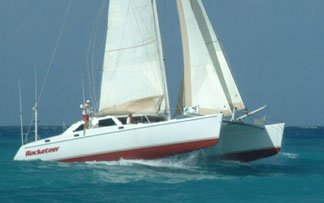 The multihull division of the Heinie proved to us, once and for all, as we have maintained, that cats can't point. If you'll remember, a few months ago, Chris White, designer of the Atlantic 55, claimed one of those boats sailed over the top of a J/160, proving her weatherly ability. Well, the humble Profligate rolled the Atlantic 55 Rocketeer, seen here, on the first leg of the first race, and never had any trouble pointing as high or higher than her. And Profligate tacks in about 110 degrees, which is at least 20 degrees worse than a J/160. We'll have a lot more on this subject in the April edition of Latitude 38.  Doña de Mallorca proudly holds the bottle of rum presented to us by John Haste of the San Diego-based Perry 52 cat Little Wing, thanks to our 'victory' over them in the Heinie. Little Wing, which was sailed by a bunch of veterans from cruising in Mexico was slowed by a three-year old Dacron main that's lost her shape, a dicey head on a jib, and other problems. However, she did finish the around-the-island race, and in the process hit an all-time best of 22.5 knots. 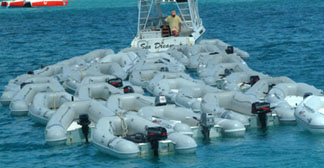 More than 150 of the Heineken entries were bareboats. Either this guy had stolen all their dinghies while they were out racing, or more likely, he was towing them back and forth between Marigot and Pelican Bay for them. Photos Vincent C. Rubino and Latitude/Richard |
New Record in Manzanillo RaceMarch 8 - Manzanillo, Mexico Last Tuesday was a 'good news/bad news' kind of day for Roy Disney, who successfully ousted Michael Eisner as chairman of Disney Corporation about the same time he lost his San Diego to Manzanillo course record. The new record holder, Dick and Mary Compton's water-ballasted Andrews 77 Alchemy, finished San Diego YC's revived race in 3 days, 23 hours, 52 minutes and 33 seconds. That obliterated the previous 5 day, 16 minute record, set in 1994 by Disney with his SC 70 Pyewacket. Staffed by an all-star crew which included Mark Rudiger, Gordon Maguire, Larry Leonard, and Mark Sims, Alchemy averaged a speedy 11.68 knots over the 1,100-mile course. "We could have towed a water-skier all the way down the Baja coast," claimed Sims. Three other big boats also broke Pyewacket's decade-old milestone: the straight-out-of-the-box Magnitude 80, which finished just five hours after Alchemy despite numerous teething problems, Medicine Man, and Victoria. The overall winner on corrected time was Bob Lane's Andrews 61 Medicine Man, which nipped Dennis Conner's R/P 50 Stars & Stripes by 18 minutes. Paddy Wagon, Richard Mainland's Ross 40, took PHRF-B, while Max and Shirley Lynn's Beneteau 40.7 Tranquility topped the Performance Cruising class. One boat, the new J/145 Stark Raving Mad, retired after a day with rudder problems. Other than a little slow going at the end, there was nothing not to like about this race. San Diego YC and the revamped Las Hadas Resort (think Bo Derek in '10') pulled out all the stops to make the event a big success. The awards ceremony, in particular, was memorable - under a rising full moon, a professional ballet troupe mesmerized the crowd with a colorful Vegas-level after-dinner show. After such a hospitable reception, it will be hard to take the race somewhere else in two years - but we've heard that PV, Cabo and Mazatlan are all also being considered. 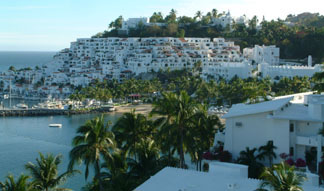 It was fun to be at Las Hadas again after a 10-year hiatus. 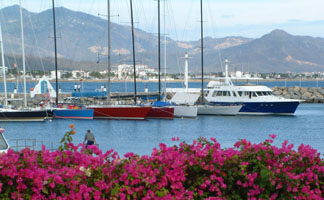 Red, white and blue at the Las Hadas docks 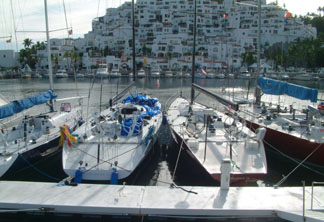 Big sticks, from left: Victoria, Magnitude 80, Alchemy and Sorcery 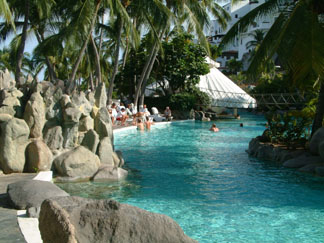 Poolside at Las Hadas |
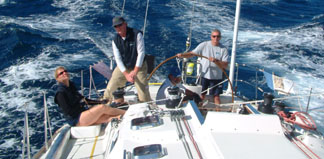 Ripping down the Baja coast on the J/160 Indigo 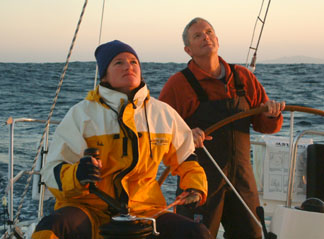 Bermuda Olympic sailor Paula Lewin and Tim Lynch enjoy an early morning watch together. 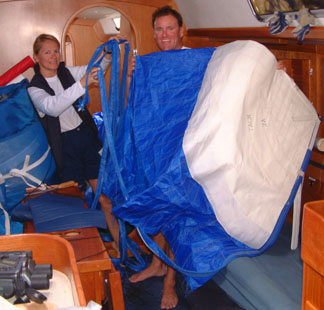 Sadly, our 2A (the vital running kite) died on the operating table less than 48 hours into the race. 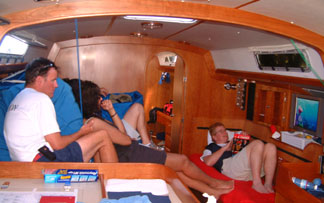 The afternoon showing of Finding Nemo 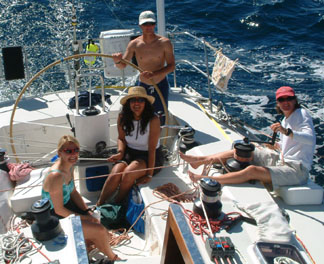 Erik Shampain steers while the 'Indigo Girls' trim. Photos Latitude/Rob Most of the 22-boat fleet is already in Puerto Vallarta now, either provisioning for the trip north or, in the case of six boats (Magnitude 80, Medicine Man, Victoria, Velos, Stars & Stripes, and Wasabi), getting ready to duke it out in MEXORC, which begins next Sunday. See www.sdyc.org for Manzanillo Race results, pictures and race manager Jeff Johnson's daily reports. Also see the April issue of Latitude 38 for more. |
Cheyenne Glides to 623-Mile RunMarch 8 - Southern Pacific Ocean Around the world in less than 60 days? Steve Fossett and crew are now halfway around the world and on such a pace. Entering the Pacific, Steve Fossett's Cheyenne scored her biggest day's run to date. On Saturday the world's biggest catamaran
crossed the international date line in record time - half way
around the world in 29 days - having racked up their fifth Currently Cheyenne is 348 nm SE of the Bounty Islands (NZ); 768 nm SE of Wellington, NZ. Predicted excellent conditions continued through the end of Day 30 as Cheyenne posted the best day yet on her Round the World record attempt - 623 miles over the past 24 hours (25.92 kts average speed) to stretch her lead over the 2002 RTW record track of Orange to 2,042 miles. |
South Africa to Field Interracial America's Cup ChallengeMarch 8 - Cape Town, South Africa South Africa will enter the America's Cup Challenge in 2007 for the first time ever. World-class Cape Town yachtsman Geoff Meek will skipper the South African entry, Shosolosa, which will be built in the city by top British designer, Jason Ker. The city's Royal Cape Yacht Club has been nominated as the South African Challenge club. The training vessel for the crew, IACC Luna Rossa, built for the Italian Prada Challenge, arrived in the Cape Town harbor today. It will be the first America's Cup yacht seen in South Africa, and marks the official start of the South African Challenge. Sailing crew signed up so far are Ian Ainslie, David Rae, Golden Mgedeza, Ashton Sampson, Marcello Burricks, Marc Lagesse and Guido Verhovert. The full crew will be selected during trials held throughout the year. Mafika Mkwanazi, former CEO of Transnet, has been appointed president of the SA America's Cup Challenge. The announcement was made this weekend
by Salvatore Sarno, chairman of See www.capetimes.co.za/index.php?fSectionId=271&fArticleId=367722 and http://tinyurl.com/3bwdn. |
On Rising from a DiveMarch 8 - Kitchener, ON, Canada Kent Hunter-Duvar, of the T26 Luff Affair, writes on the subject of rising from a dive safely: "Stuck here in the frozen North, I look forward to each new edition [of 'Lectronic Latitude]. Just reading the latest (March 5) and as a fairly experienced scuba diver, the last story "Rise No Faster than Your Bubbles" causes me great concern. While in their particular situation (OOA) an emergency ascent was indicated, the recommendation to rise no faster than your bubbles is false and very likely to cause serious injury. Current guidelines and training recommend an ascent rate of 30 feet/minute or less (so about 80 seconds from 40 feet) with an absolute maximum ascent rate of 60 feet/minute. Anything faster drastically increases your risk of DCI (the bends). This applies to hooka as well as scuba diving as in both cases you are breathing air under pressure equivalent to the surrounding water pressure. It does not apply to freediving (breath hold diving) as the lack of compressed breathing gas makes it entirely different and the time period of the dive is much shorter. "It is my opinion that anyone using hooka should complete a basic (open water level) scuba course in order to know the risks and proper techniques, including such issues as ascent (and descent) rates and dive tables. For example the U.S. Navy dive tables indicate a max of 60 minutes at 60 feet for no decompression diving, anything beyond that and decompression stops are required (or at least highly recommended) on ascent. And all training agencies recommend a minimum 3 minutes 'safety stop' at 15 feet on EVERY dive. If you're interested in more info, I'd recommend a visit to Divers Alert Network at www.diversalertnetwork.org. Membership is very low cost and provides for free emergency transportation and access to advice from specialists in dive medicine in case of a dive injury, including locating the nearest hyperbaric chamber if recompression therapy is required, as well as access to non-emergency medical help and advice." |
Piracy in the Gulf of AdenMarch 8 - Gulf of Aden Katie and Don Radcliffe of Santa Cruz, sailing in the Red Sea, report that two attempts at piracy have been made on their yacht, Klondike, in the Gulf of Aden. They will be in Massawa, Eritrea, shortly and will try to send us details and photos. They comment on communications in the Red Sea: "Both Sailmail and Winlink (Ham) present challenges in connecting with distance transmitters here in the Red Sea. Winlink with transmitters in Italy and Qatar has been more user friendly. Winlink allows 30 minutes/day per station versus the 10 that Sailmail gives totally. You've got more time to make several attempts at connection to Winlink. Transmitters for Sailmail are located in Belgium, Mozambique and Brunei. Late evening connections to Brunei have given the best results on Sailmail." |
YOTREPSMarch 8 - The Pacific Ocean and Cyberspace Who is out making passages in the Pacific and what kind of weather are they having? The YOTREPS daily yacht tracking page has moved to www.bitwrangler.com/psn. |
Weather LinksMarch 8 - Pacific Ocean San Francisco Bay WeatherCheck out this guide to San Francisco Bay Navigational Aids: http://sfports.wr.usgs.gov/sfports.html. To see what the winds are like on the Bay and just outside the Gate right now, check out http://sfports.wr.usgs.gov/wind. The National Weather Service site for San Francisco Bay is at www.wrh.noaa.gov/Monterey. California Coast WeatherLooking for current as well as recent wind and sea readings from 17 buoys and stations between Pt. Arena and the Mexican border? Here's the place - which has further links to weather buoys and stations all over the U.S.: www.ndbc.noaa.gov/Maps/Southwest.shtml. Pacific Winds and PressureThe University of Hawaii Dept. of Meteorology page posts a daily map of the NE Pacific Ocean barometric pressure and winds. Pacific Sea StateThe site for the Pacific Ocean sea states
has moved to http://www.mpc.ncep.noaa.gov/shtml/PacRegSSA.shtml.
|